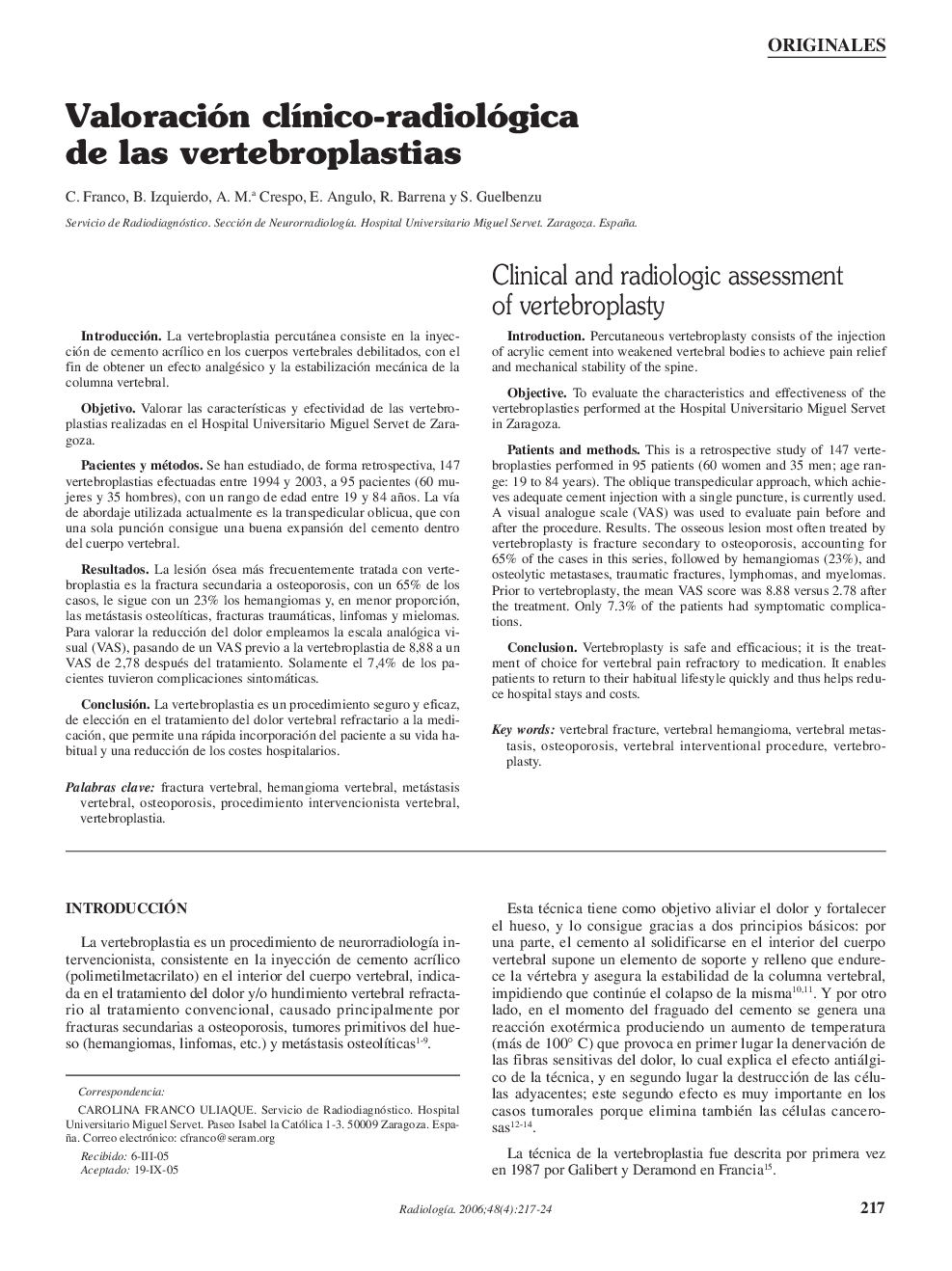| Article ID | Journal | Published Year | Pages | File Type |
|---|---|---|---|---|
| 4246318 | Radiología | 2006 | 8 Pages |
IntroducciónLa vertebroplastia percutánea consiste en la inyección de cemento acrÃlico en los cuerpos vertebrales debilitados, con el fin de obtener un efecto analgésico y la estabilización mecánica de la columna vertebral.ObjetivoValorar las caracterÃsticas y efectividad de las vertebroplastias realizadas en el Hospital Universitario Miguel Servet de Zaragoza.Pacientes y métodosSe han estudiado, de forma retrospectiva, 147 vertebroplastias efectuadas entre 1994 y 2003, a 95 pacientes (60 mujeres y 35 hombres), con un rango de edad entre 19 y 84 años. La vÃa de abordaje utilizada actualmente es la transpedicular oblicua, que con una sola punción consigue una buena expansión del cemento dentro del cuerpo vertebral.ResultadosLa lesión ósea más frecuentemente tratada con vertebroplastia es la fractura secundaria a osteoporosis, con un 65% de los casos, le sigue con un 23% los hemangiomas y, en menor proporción,las metástasis osteolÃticas, fracturas traumáticas, linfomas y mielomas.Para valorar la reducción del dolor empleamos la escala analógica visual (VAS), pasando de un VAS previo a la vertebroplastia de 8,88 a un VAS de 2,78 después del tratamiento. Solamente el 7,4% de los pacientes tuvieron complicaciones sintomáticas.ConclusiónLa vertebroplastia es un procedimiento seguro y eficaz, de elección en el tratamiento del dolor vertebral refractario a la medicación, que permite una rápida incorporación del paciente a su vida habitual y una reducción de los costes hospitalarios.
IntroductionPercutaneous vertebroplasty consists of the injection of acrylic cement into weakened vertebral bodies to achieve pain relief and mechanical stability of the spine.ObjectiveTo evaluate the characteristics and effectiveness of the vertebroplasties performed at the Hospital Universitario Miguel Servet in Zaragoza.Patients and methodsThis is a retrospective study of 147 vertebroplasties performed in 95 patients (60 women and 35 men; age range: 19 to 84 years). The oblique transpedicular approach, which achieves adequate cement injection with a single puncture, is currently used. A visual analogue scale (VAS) was used to evaluate pain before and after the procedure.ResultsThe osseous lesion most often treated by vertebroplasty is fracture secondary to osteoporosis, accounting for 65% of the cases in this series, followed by hemangiomas (23%), and osteolytic metastases, traumatic fractures, lymphomas, and myelomas. Prior to vertebroplasty, the mean VAS score was 8.88 versus 2.78 after the treatment. Only 7.3% of the patients had symptomatic complications.ConclusionVertebroplasty is safe and efficacious; it is the treatment of choice for vertebral pain refractory to medication. It enables patients to return to their habitual lifestyle quickly and thus helps reduce hospital stays and costs.
